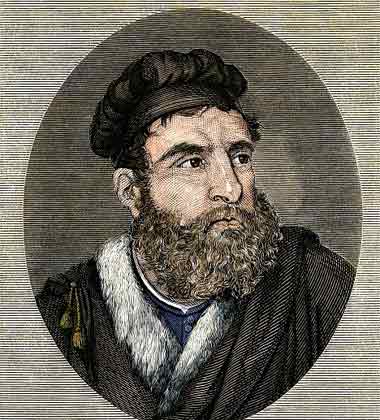|
 Travelling trickster? Marco Polo may have fabricated his experiences by using other people's stories. |
|
One of history’s greatest explorers, may in fact have been a conman, it was claimed yesterday. Far from being a trader who spent years in China and the Far East, he probably never went further east than the Black Sea, according to a team of archaeologists. They suspect the Venetian adventurer picked up stories about the mysterious lands of the Orient from fellow traders around the Black Sea who related tales of China, Japan and the Mongol Empire in the 13th century. He then put the stories together in a book commonly called The Travels of Marco Polo, hailed as one of the first travel books; it purports to be his account of his journeys through Persia, Asia and the Far East between 1271 and 1291. It details his relations with Kublai Khan, the Mongol ruler who became Emperor of China. But now an Italian team of archaeologists studying in Japan have cast doubts about one of Italy’s great national heroes -- although there have been competing claims to him from Croatia, which argues he was born there. The doubters told Italian history magazine Focus Storia that there were numerous inconsistencies and inaccuracies in Marco Polo’s description of Kublai Khan’s attempted invasions of Japan in 1274 and 1281. 'He confuses the two, mixing up details about the first expedition with those of the second. 'In his account of the first invasion, he describes the fleet leaving Korea and being hit by a typhoon before it reached the Japanese coast,' said Professor Daniele Petrella of the University of Naples, the leader of the archaeology team. 'But that happened in 1281 – is it really possible that a supposed eye witness could confuse events which were seven years apart?' He said that Polo’s description of the Mongol fleet did not square with the remains of ships that the team had excavated in Japan, as he had written of ships with five masts, while those which had been found had only three. 'When he describes Kublai Khan’s fleet he talks about the pitch that was used to make ships’ hulls watertight. He used the word 'chunam’, which in Chinese and Mongol means nothing. 'In fact, it is the Persian word for pitch. It’s also odd that instead of using, as he does in most instances, local names to describe places, he used Persian terms for Mongol and Chinese place names.' The explorer claimed to have worked as an emissary to the court of Kublai Khan, but his name does not crop up in any of the surviving Mongol or Chinese records. (Read by Nelly Min. Nelly Min is a journalist at the China Daily Website.) (Agencies) |
昨日有消息称,历史上最伟大的探险家之一可能事实上是个大骗子。 据一个考古队称,马可•波罗可能根本不是在中国和远东行走多年的商人,很可能都没到过比黑海更远的地方。 他们怀疑这位威尼斯探险家从一些黑海地区的商人伙伴那里听来了很多关于那片神秘的东方大地的故事。他们向他讲述了很多13世纪中国、日本和蒙古帝国的传说。 后来他将这些故事集成一本书,也就是为世人所熟知的《马可•波罗游记》,这本书号称是最早的旅游书籍之一,并包含他1271年到1291年间游历波斯、亚洲和远东的记录。 书中详细讲述了他和蒙古统治者忽必烈的交情,忽必烈后来成为了中国的一代帝王。 但如今一个在日本开展研究的意大利考古队对这位意大利民族大英雄产生了质疑。不过关于马克•波罗的国籍,克罗地亚坚称他是克罗地亚人,说他出生在那里。 怀疑者们告诉意大利历史杂志《聚焦历史》说,马可•波罗关于忽必烈1274年和1281年两次试图入侵日本的描述中,存在诸多不一致和不准确的地方。 “他将忽必烈第一次和第二次远征的细节弄混了。” “在描述第一次入侵日本时,他说舰队刚离开高丽(今天的朝鲜、韩国)就遭遇了台风,没能抵达日本海岸。”这支考古队的领队、那不勒斯大学教授丹尼尔•彼得雷拉说道。 “但那其实是1281年时候的事——如果是亲眼所见,怎么可能将相隔七年之久的两个事件搞混?” 他还说,马可•波罗关于蒙古舰队的描述也与考古队在日本挖掘出来的船舶遗骸不相符,他所记录的舰船有5支桅杆,而所发掘出的舰船只有3支桅杆。 “当他写到忽必烈的舰队时,他提到用沥青做船体防水,他用的词是‘chunam’,而在中文和蒙文中并没有这个词。 “实际上,这是个用来表示沥青的波斯文词语。而且,大多数时候他都会使用当地的地名,但是这次他却用波斯文词语来指称蒙古和中国的地方,这也很奇怪。” 这位探险家自称曾作为使节去朝见忽必烈,但现存的蒙古或中国史料记载中都找不到他的名字。 相关阅读 (中国日报网英语点津 实习生沈清 编辑:陈丹妮) |
|
Vocabulary: conman: 骗子 purport to: 声称,号称 square: 使一致,使相符 excavate: 发掘(古物等) emissary: 使者 crop up: 出现 |
